8.08.2021
Excitement as Mars rover drills first rock core for return to Earth
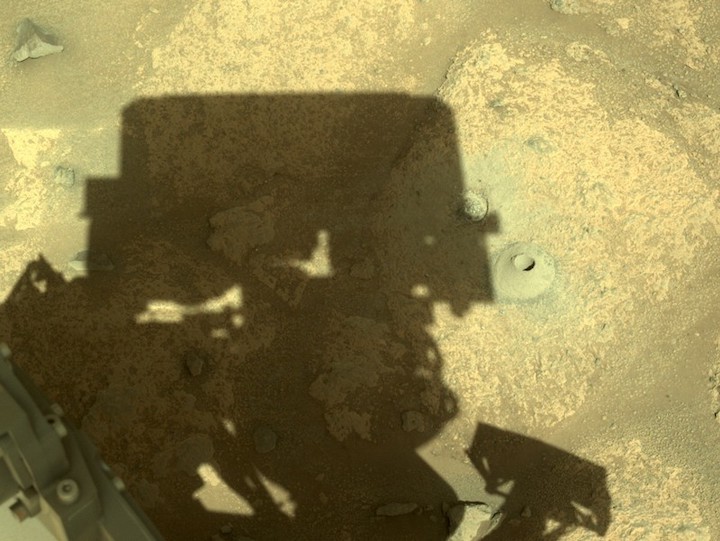
NASA's Perseverance rover drilled its first rock core on Mars on 6 August. The drill area appears as a small circular cone just to the right of the rover's shadow.Credit: NASA/JPL-Caltech
Update: NASA announced late on 6 August that the rock core drilled by Perseverance failed to appear in its storage tube, despite initial data indicating that the tube processed as intended. NASA is assessing the situation to determine what went wrong. Nature will provide updates when they are available.
A robot on Mars has just collected the first-ever piece of Martian rock that is destined to be brought to Earth — and scientists are thrilled that it could be volcanic in origin. If confirmed, this means that, once the sample comes back to Earth, researchers could determine its age and gain insights into the planet’s fiery past.
After days of seeking the perfect spot to drill on the floor of Mars’s Jezero Crater and prepping it, NASA’s Perseverance rover collected the rock core, which is about the size of a piece of classroom chalk, on 6 August. The rover has been exploring the crater since landing there in February, with the goal of discovering whether life ever existed on the red planet.
The core sample, which was drilled from a flat rock that looks like the kind of stone used to pave walkways, doesn’t contain any obvious signs of life. But it does hold a rich mix of tiny, multicoloured rock grains that were possibly created during an ancient meteorite impact or volcanic eruption. If and when the core arrives back on Earth — which would be no earlier than the year 2031, after a complex series of spacecraft retrieve it, along with other samples — researchers can analyse it to determine a precise date for when it formed.
“This core sample feels truly momentous,” says Meenakshi Wadhwa, a planetary scientist at Arizona State University in Tempe and NASA’s principal scientist for the joint NASA–European Space Agency effort to bring Perseverance’s cores back to Earth. “To me, it marks the beginning of Mars sample return — it finally feels real.”
The rover’s successful drilling marks a major accomplishment for the US$2.4-billion mission. It is the first step in collecting a series of 30 or more rock samples from across Jezero Crater, in an effort to build a library representing the geologic history of the area and any potential life that might once have existed there. Billions of years ago, Jezero was home to an ancient river delta and lake that could have been hospitable to life.
Prior to drilling, Perseverance dusted and lightly scraped the sampling area to reveal a variety of different-coloured minerals hinting that it might be volcanic rock.Credit: NASA/JPL-Caltech
If the samples are successfully collected and dated, it would be the first-ever pinpointing of the age of a rock on Mars. Scientists have evaluated the ages of Martian meteorites collected on Earth, but don’t know where exactly on Mars’s surface they came from — making it impossible to nail down an exact age for a specific set of rocks. Having a date from an intact rock would fundamentally transform scientific knowledge of the Martian surface.
Until now, scientists have been able only to guess at the ages of rock types on Mars, by estimating how many meteorite impacts have punched into them over time. With even just one dated rock to calibrate that, “we would make huge inroads to how we understand the timing of processes on Mars”, says Linda Kah, a geologist at the University of Tennessee in Knoxville and a member of Perseverance’s science team.
Igneous possibilities
The flat stones that Perseverance sampled cover part of the floor of Jezero Crater. Since leaving its landing site, the rover has driven about 1 kilometre across similar stones, which mission scientists are calling “cratered floor fractured rough”, a bland description that reflects how little they know about the rocks. For months, they have not been able to say whether these stones are igneous in origin — meaning they came from a volcanic eruption or other process involving molten rock — or sedimentary — meaning they were laid down, with one layer atop another, through a different geological process.
Now, however, many bets are on the rock being igneous, on the basis of initial appearances and preliminary data. Days before drilling the core, Perseverance dusted off and lightly scraped the stone at the spot it chose to drill — similar to polishing the surface of a dusty countertop to see what it looks like below the grime. That polished spot, around 45 millimetres across, revealed the astonishing array of multicoloured rock grains. “Just from the images, it looks like we have volcanic or igneous minerals,” says Kah. For instance, the whitish grains look like an igneous mineral known as feldspar.
Perseverance drilled and collected its first sample from Mars's Jezero Crater using its robotic arm.Credit: NASA/JPL-Caltech
Larger gaps that look like holes could be the remnants of gas bubbles, glass blobs, or other features that formed within molten rock before it solidified. Because igneous rocks form directly from molten rock, scientists can use the decay of radioactive minerals in the rock grains to determine when the rock cooled and crystallized, and thus its age.
“There’s a lot of excitement about it being a lava flow, potentially,” says Briony Horgan, a geologist at Purdue University in West Lafayette, Indiana, and a member of the rover’s science team. But much work remains to be done to confirm or refute these initial ideas by using more instruments aboard Perseverance that can, for instance, probe the rock’s mineralogy in different ways. Laboratory analyses on Earth will also reveal much more. “What’s really great about this mission is we’re going to get this rock back,” says Horgan.
Rolling onwards
The rover might collect a second core of the cratered floor fractured rough to have two samples for its core library, because the geology appears to be so important.
Perseverance will next head south along the crater floor and probably collect its next drill cores at a nearby area named Séítah, which is full of sand dunes, and an enigmatic region known as the Raised Ridges. Both represent different types of rock than the ‘paving stone’ that Perseverance has just drilled. The rover will probably keep exploring around Jezero’s floor until early 2022, and then will head towards the ancient river delta that is the mission’s ultimate target, collecting more cores as it goes.
Perseverance is accompanied by a helicopter named Ingenuity, the first rotorcraft to ever fly on Mars. It has made 11 flights so far, often scouting terrain around the rover so that scientists can better see where they might want to explore next.
Other accomplishments since February include taking photographs of rocks in the distance that appear to be many tumbled boulders atop layers of more tranquil-looking sediment. Such formations suggest that one or more flash floods once ripped through Jezero, leaving jumbles of debris in their wake, the mission’s chief scientist, Ken Farley, said at a press briefing last month. He called it the most surprising finding of the mission to date.
Quelle: nature
----
Update: 13.08.2021
.
NASA blames Mars rover sampling fiasco on bad, powdery rock
NASA is blaming unusually soft rock for last week's sampling fiasco on Mars
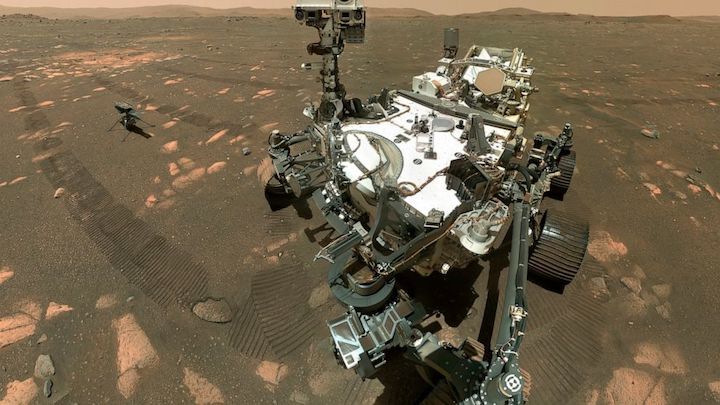
CAPE CANAVERAL, Fla. -- NASA is blaming unusually soft rock for last week’s sampling fiasco on Mars.
The Perseverance rover came up empty after attempting to collect its first core sample on the red planet for eventual return to Earth. Data beamed back last Friday showed that the rover drilled to the proper depth of nearly 3 inches (8 centimeters), and pictures of the borehole looked good. But it quickly became clear the sample tube was empty.
Since then, engineers have determined the rock was not strong enough to produce a core sample, and the small, powdery fragments remained in the hole or ended up in the cuttings pile — or both. So the rover is moving on to the next sampling site in its quest for signs of ancient Martian life; it should arrive there by early next month.
Imaging by the rover and its companion helicopter, Ingenuity, show the sedimentary rock should be much better for sampling there, Louise Jandura, chief engineer for Perseverance's sampling campaign, said Wednesday.
“The hardware performed as commanded but the rock did not cooperate this time," Jandura wrote in an online update.
“It reminds me yet again of the nature of exploration,” she said. "A specific result is never guaranteed no matter how much you prepare.”
NASA is looking to collect about 35 samples that would be returned via future spacecraft in a decade.
It’s not the first time that a Mars lander has run into ground resistance. A German digger on NASA’s InSight lander failed to burrow more than a couple feet, far short of its target. The clumping soil didn’t provide enough friction for the heat-measuring device, and experimenters gave up in January.
The little helicopter, Ingenuity, meanwhile, is still wowing its team. It's completed 11 test flights, the latest one lasting more than two minutes, and even conducted aerial surveys of Jezero Crater. That's the ancient river delta where Perseverance and its hitchhiking chopper landed in February, following a nearly seven-month flight from Earth. Scientists believe the area would have been prime for microscopic life billions of years ago, if it existed.
Quelle: abcNews
+++
NASA’s Ingenuity Mars Helicopter Spots Perseverance From Above
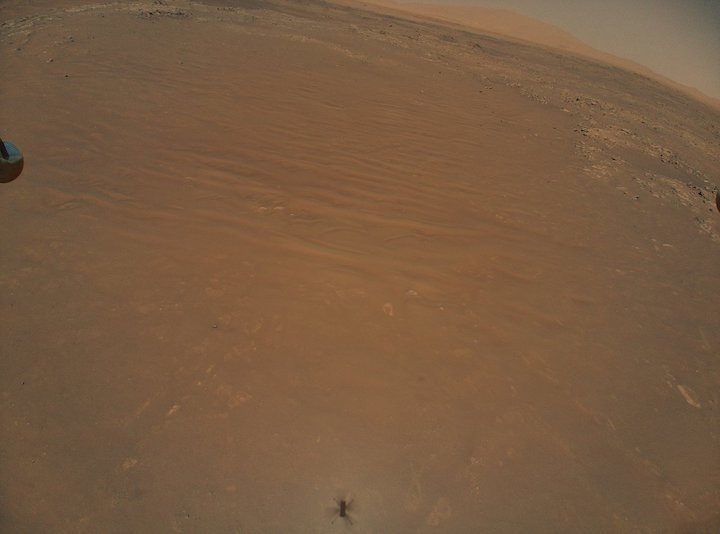
This image of the “South Séítah” region of Jezero Crater was taken by NASA’s Ingenuity Mars Helicopter during its 11th flight on Aug. 4.
Credit: NASA/JPL-Caltech
Can you see NASA’s newest rover in this picture from Jezero Crater?
NASA’s Ingenuity Mars Helicopter recently completed its 11th flight at the Red Planet, snapping multiple photographs during its trip. Along with capturing the boulders, sand dunes, and rocky outcrops prevalent in the “South Séítah” region of Jezero Crater, a few of the images capture NASA’s Perseverance rover amid its first science campaign.
Ingenuity began as a technological demonstration to prove that powered, controlled flight on Mars is possible. It is now an operations demonstration intended to investigate how a rotorcraft can add an aerial dimension to missions like Perseverance, scouting possible areas of scientific interest and offering detailed views of nearby areas too hazardous for the rover to explore.
“Ingenuity’s aerial images are awesome – but even better when you get to play ‘Where’s Perseverance?’ with them,” said Robert Hogg. “Once you find our rover and zoom in, you can make out some details, like the wheels, remote sensing mast, and the MMRTG” – the Multi-Mission Radioisotope Thermoelectric Generator – “on the aft end.”
So where is Perseverance? At the bottom center of the image, you can find Ingenuity’s shadow. From there, go straight up. Just beyond South Seítah’s dune field near the top of the image and just to the right of center is a bright white speck. That’s what a Mars rover looks like from about 1,600 feet (500 meters) away and 39 feet (12 meters) up.

Ingenuity captured the Perseverance rover in an image taken during its 11th flight at Mars on Aug. 4.
Flight 11 was essentially designed to keep Ingenuity ahead of the rover, allowing it to continue to support Perseverance’s science goals by photographing intriguing geologic features from the air. Flying north-by-northwest at 11 mph (five meters per second), it took Ingenuity 130.9 seconds to make the trip to its 8th airfield. From this new staging area, the helicopter is scheduled to make at least one reconnaissance flight of the geologically intriguing South Séítah area.
More About Ingenuity
The Ingenuity Mars Helicopter was built by JPL, which also manages the technology demonstration project for NASA Headquarters. It is supported by NASA's Science, Aeronautics Research, and Space Technology mission directorates. NASA's Ames Research Center in California’s Silicon Valley, and NASA’s Langley Research Center in Hampton, Virginia, provided significant flight performance analysis and technical assistance during Ingenuity's development. AeroVironment Inc., Qualcomm, and SolAero also provided design assistance and major vehicle components. Lockheed Martin Space designed and manufactured the Mars Helicopter Delivery System.
More About Perseverance
A key objective for Perseverance’s mission on Mars is astrobiology, including the search for signs of ancient microbial life. The rover will characterize the planet’s geology and past climate, pave the way for human exploration of the Red Planet, and be the first mission to collect and cache Martian rock and regolith.
Subsequent NASA missions, in cooperation with ESA (European Space Agency), would send spacecraft to Mars to collect these sealed samples from the surface and return them to Earth for in-depth analysis.
The Mars 2020 Perseverance mission is part of NASA’s Moon to Mars exploration approach, which includes Artemis missions to the Moon that will help prepare for human exploration of the Red Planet.
JPL, which is managed for NASA by Caltech in Pasadena, California, built and manages operations of the Perseverance rover.
Quelle: NASA
----
Update: 16.08.2021
.
Aviation Week Awards NASA’s Ingenuity Mars Helicopter With Laureate
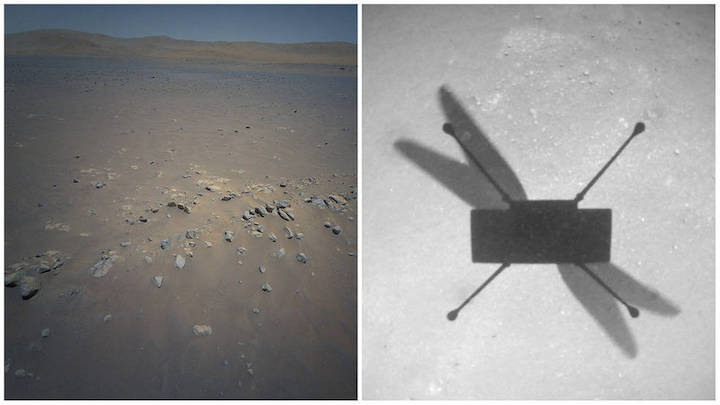
The prestigious honor recognizes the pioneering rotorcraft for its history-making flights on the Red Planet.
The “little helicopter that could” has garnered attention, fans, and numerous accolades, with the latest coming from Aviation Week Network in the form of a 2021 Laureate Award. The Laureate Awards honor “extraordinary achievements in aerospace.”
When the 4-pound (1.8 kilogram) rotorcraft hovered on Mars for 39.1 seconds on April 19, 2021, it was the first instance of powered, controlled flight on another planet – a true Wright brothers moment. Since then, Ingenuity has chalked up 11 flights, with a total distance of just over 1 mile (2.2 kilometers), reaching an altitude record of 40 feet (12 meters) in its 10th sortie.
Ingenuity hitched a ride to the Red Planet on Perseverance, which landed on Feb. 18 2021. It was designed as a technology demonstration and carries no science payloads on board. Its mission was to prove that humanity can fly powered vehicles on Mars.
After Ingenuity achieved its tech demo goals, the helicopter entered its current operations demonstration phase to test its abilities as an aerial explorer, quickly imaging and scouting areas of Mars. This capability has proven useful to Perseverance operators and scientists. During its most recent flights, Ingenuity has surveyed areas of particular interest for Perseverance to potentially explore in its hunt for signs of ancient life.
“The helicopter has succeeded in ways the Ingenuity team could only have imagined at the outset of this project,” said Ingenuity Operations Lead Teddy Tzanetos. “The small but mighty team behind this small but mighty rotorcraft is, needless to say, thrilled at its success and honored for the acknowledgment. We’re also eager to see what comes next with the operations demonstration.”
The helicopter is paving the way for possible future missions that could use rotorcraft to help scout, explore, and even carry science payloads on other worlds.
Quelle: NASA
----
Update: 18.08.2021
.
NASA's Ingenuity helicopter completes 12th Mars flight
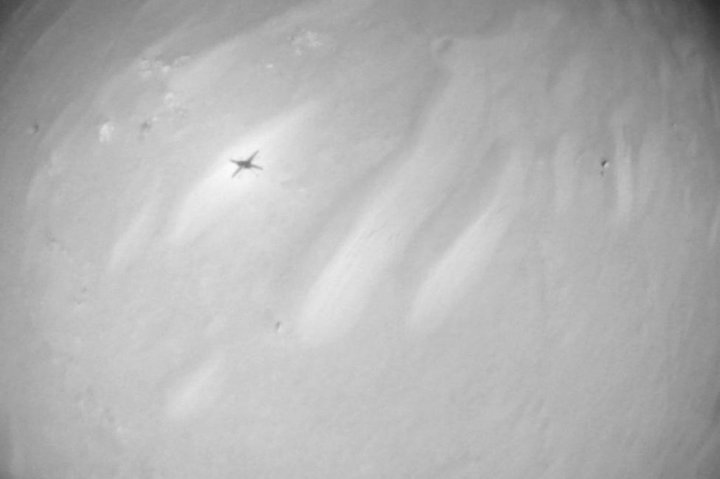
The shadow of NASA's Ingenuity helicopter is seen in a photo taken by the chopper during its 12th flight of Mars, during which it flew over the South Seitah region of the Red Planet for 169 seconds. Photo courtesy of NASA Jet Propulsion Laboratory/Twitter
NASA's Ingenuity helicopter completed its 12th flight on Mars, officials said early Tuesday, as it scouts out the Martian terrain for the Perseverance land rover.
The 4-pound autonomous aircraft flew over the South Seitah region of the Red Planet, traveling a total of 1,476 feet round trip at a height of nearly 33 feet for 169 seconds, NASA's Jet Propulsion Laboratory said via Twitter.
"A dozen for the books!" it said. "The Mars helicopter's latest flight took us to the geological wonder that is the 'South Seitah' region."
The California-based JPL, a federally funded research and development center run by NASA and the California Institute of Technology, explained the chopper is conducting aerial scouting and captured images aiming to help the team behind NASA's Persevere determine which boulders, rocky outcrops and other geologic features "may be worthy of further scrutiny" by the land rover.
Flight 12 was to be similar to Flight 10 in that Ingenuity was to perform scouting duties of a surface feature called "Raised Ridges" but members of Ingenuity's team said in a blog post prior to liftoff without elaborating that it could have "more impactful results."
Ten color photographs were to be taken, the team leaders said.
The flight, they added, was to come with substantial risk due to the region's varied terrain and Ingenuity's navigation system being intended for flights across flat land, but what could be gained from the endeavor was worth the risk.
"Knowing that we have the opportunity to help the Perseverance team with science planning by providing unique aerial footage is all the motivation needed," they said.
Perseverance is moving northwest across the southern ridge of Seitah and is expected to meet up with Ingenuity in the coming days, the JPL said.
The helicopter landed upon Mars in February while attached to the underside of the Perseverance rover, and took its median flight on April 19, climbing to about 10 feet before completing a turn and descending back to the planet's surface.
Since then, Ingenuity has logged more than 20 minutes in Martian air, covering more than 1.2 nautical miles.
Quelle: UPI
----
Update: 27.08.2021
.
NASA’s Perseverance Plans Next Sample Attempt
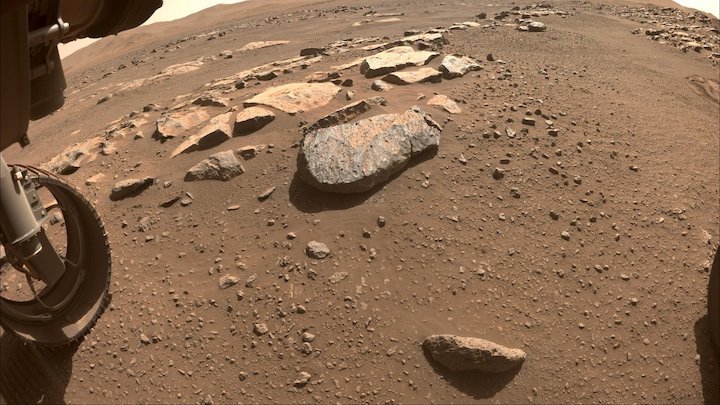
Credit: NASA/JPL-Caltech
The rover will abrade a rock this week, allowing scientists and engineers to decide whether that target would withstand its powerful drill.
In its search for signs of ancient microbial life on Mars, NASA’s Perseverance rover is once again preparing to collect the first of many rock core samples that could eventually be brought to Earth for further study.
This week, a tool on the rover’s 7-foot-long (2-meter-long) robotic arm will abrade the surface of a rock nicknamed “Rochette,” allowing scientists to look inside and determine whether they want to capture a sample with the rover’s coring bit. Slightly thicker than a pencil, the sample would be sealed in one of the 42 remaining titanium tubes aboard the rover.
Should the team decide to acquire a core from this rock, the sampling process would be initiated next week.
The mission attempted to capture their first record of the crater floor on Aug. 6 from a rock that ultimately proved too crumbly, breaking into powder and fragments of material too small to be retained in the sample tube before it was sealed and stored within the rover.
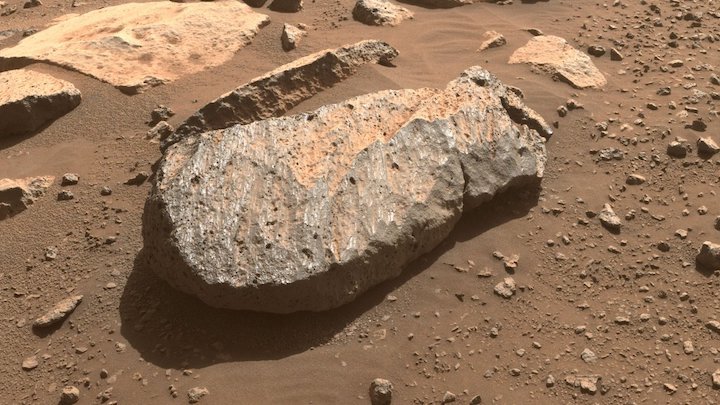
A close-up of the rock, nicknamed “Rochette,” that the Perseverance science team will examine in order to determine whether to take a rock core sample from it.
Credit: NASA/JPL-Caltech
Perseverance has since trucked 1,493 feet (455 meters) to a ridge nicknamed “Citadelle” – French for “castle,” a reference to how this craggy spot overlooks Jezero Crater’s floor. The ridge is capped with a layer of rock that appears to resist wind erosion, a sign that it’s more likely to hold up during drilling.
“There are potentially older rocks in the ‘South Séítah’ region ahead of us, so having this younger sample can help us reconstruct the whole timeline of Jezero,” said Vivian Sun, one of the mission’s scientists at NASA’s Jet Propulsion Laboratory in Southern California.
The team has added a step to the sampling process for this coming attempt: After using its Mastcam-Z camera system to peer inside the sample tube, the rover will pause the sampling sequence so the team can review the image to ensure a rock core is present. Once a sample is confirmed, they will command Perseverance to seal the tube.
Although the pulverized rock eluded capture in the initial sample-acquisition effort, the first sample tube still contains a sample of Martian atmosphere, which the mission had originally planned to acquire at a later time.
“By returning samples to Earth, we hope to answer a number of scientific questions, including the composition of Mars’ atmosphere,” said Ken Farley, Perseverance’s project scientist at Caltech in Pasadena, California. “That’s why we’re interested in an atmospheric sample along with rock samples.”
While atop Citadelle, Perseverance will use its subsurface radar, called RIMFAX– short for Radar Imager for Mars’ Subsurface Experiment – to peer at rock layers below it. The top of the ridge will also provide a great vantage point for Mastcam-Z to look for other potential rock targets in the area.
More About the Mission
A key objective for Perseverance’s mission on Mars is astrobiology, including the search for signs of ancient microbial life. The rover will characterize the planet’s geology and past climate, pave the way for human exploration of the Red Planet, and be the first mission to collect and cache Martian rock and regolith (broken rock and dust).
Subsequent NASA missions, in cooperation with ESA (European Space Agency), would send spacecraft to Mars to collect these sealed samples from the surface and return them to Earth for in-depth analysis.
The Mars 2020 Perseverance mission is part of NASA’s Moon to Mars exploration approach, which includes Artemis missions to the Moon that will help prepare for human exploration of the Red Planet.
JPL, which is managed for NASA by Caltech, built and manages operations of the Perseverance rover.
Quelle: NASA
----
Update: 6.09.2021
.
Mars rover: Nasa confirms Perseverance has its first rock sample
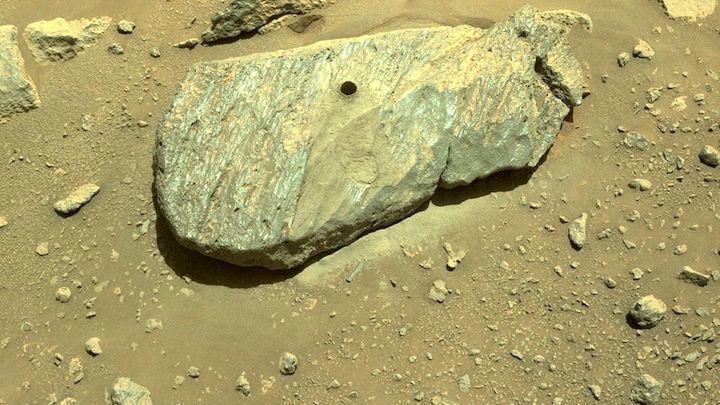
The US space agency has confirmed that its Perseverance rover has retrieved its first rock sample on Mars.
There were an anxious few days after the robot drilled into a thick slab dubbed "Rochette" that the core might have been dropped.
But new images of the drill head show the sample safely inside the mechanism.
It's a historic moment. The core represents the first ever rock section collected on another planet intended for return to Earth.
The rover is tasked with gathering more than two dozen such samples over the next year or so that will be fetched home by a joint US and European effort later this decade.
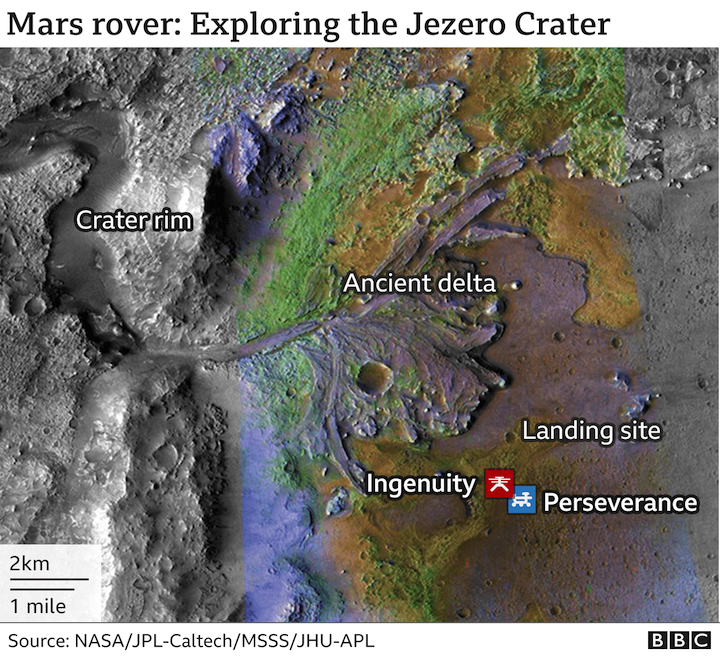
Nasa's Perseverance robot landed in Mars' Jezero Crater in February.
The deep, 45km-wide depression, some 20 degrees north of the planet's equator, looks to have held a lake billions of years ago.
Because of this, scientists think Jezero's sediments may hold traces of ancient microbial life - assuming biology ever took hold on Mars.
From its touchdown location, the robot has driven more than 2km to a slightly raised ridge nicknamed the Citadelle.
It's here that the Perseverance team selected Rochette as the target for the latest drilling attempt.
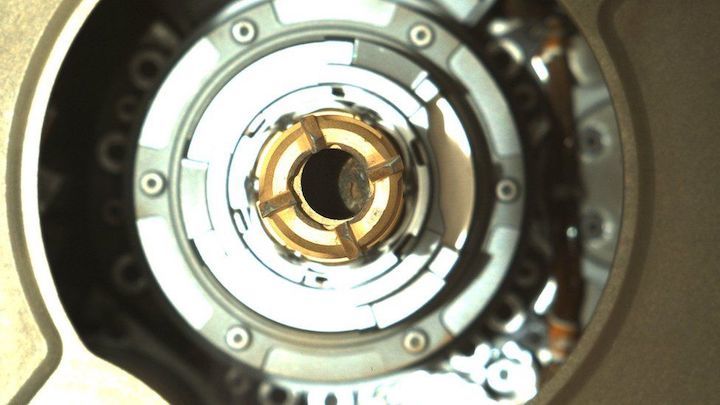
The robot is equipped with a caching system that will take a finger-sized core of rock cut by the drill and place it in a titanium tube.
Before sealing this cylinder, however, the rover will image the contents. It was at this stage in early August during a first sampling attempt that Perseverance scientists realised they had nothing in the tube; the coring mechanism had shattered the rock to a powder that then fell back on to the ground around the drill hole.
But the mission team were encouraged by the first pictures downlinked by Perseverance on Thursday which appeared to indicate rocky material from Rochette in the corer head at the entrance to the cylinder. The very latest pictures confirm it.
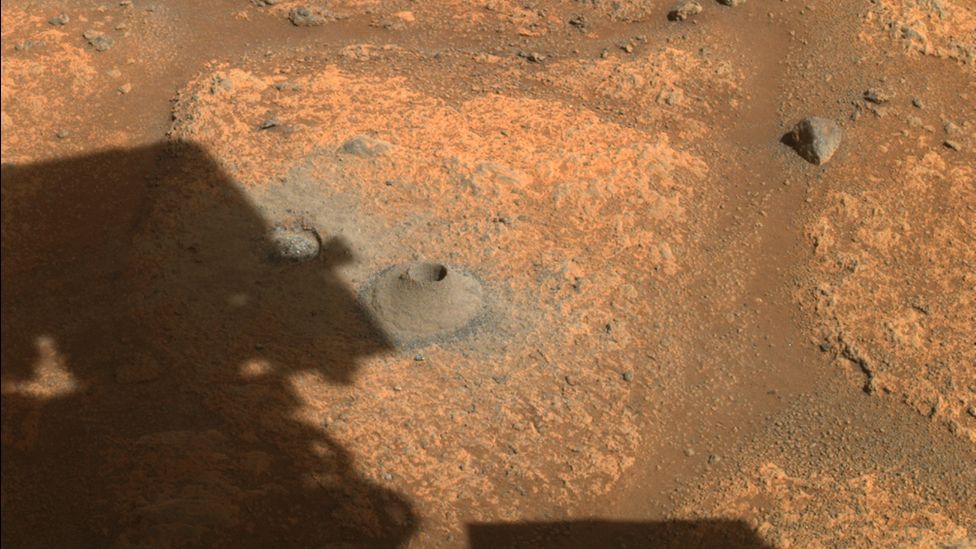 IMAGE SOURCENASA/JPL-CALTECH
IMAGE SOURCENASA/JPL-CALTECHThe rover must now fully process the sample within its belly.
Perseverance continues to be shadowed by its mini-helicopter, Ingenuity.
Originally taken to Mars as a technology demonstration, the drone is now being used routinely to scout the terrain ahead of the rover.
Ingenuity has made a total of 13 flights.
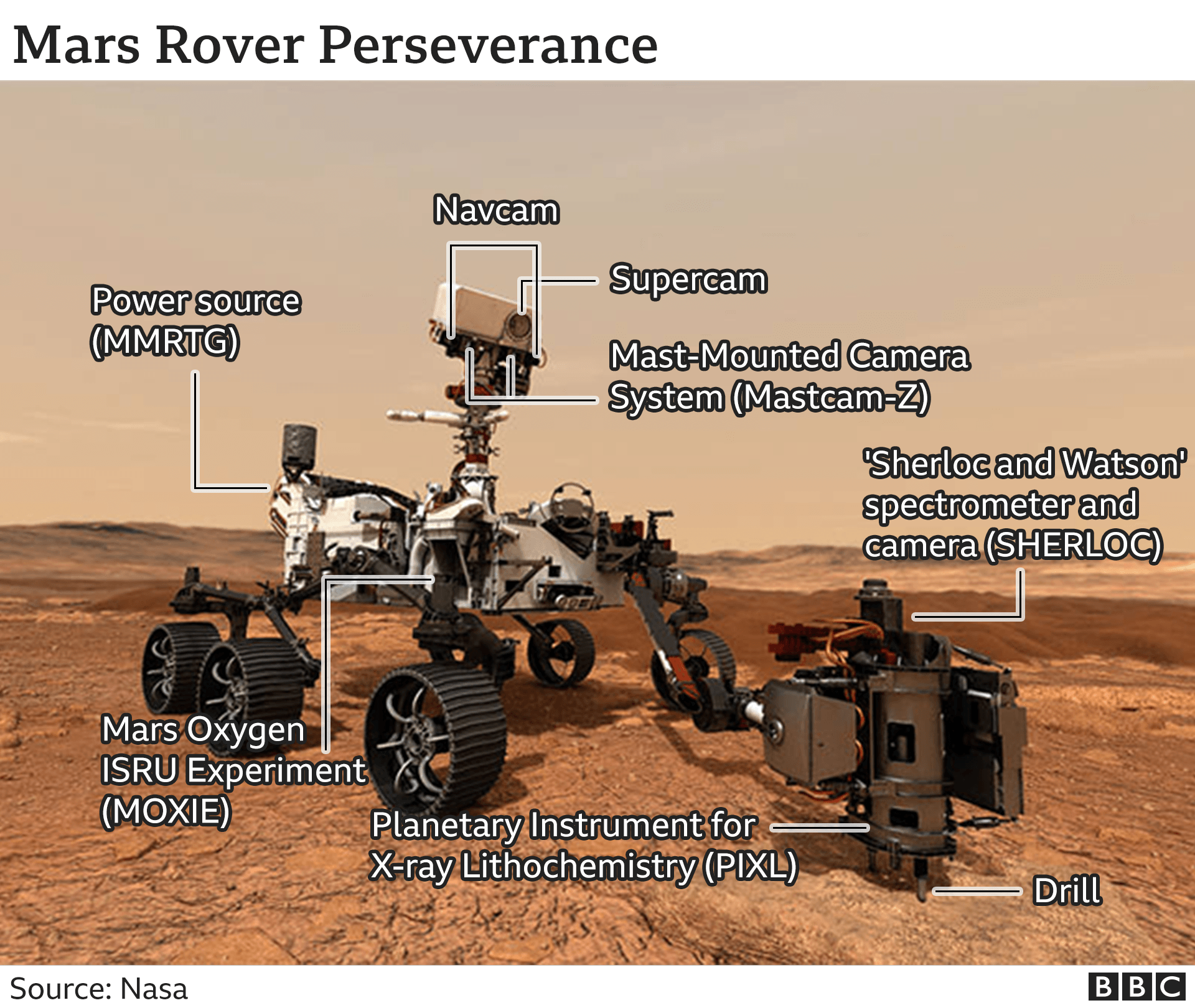
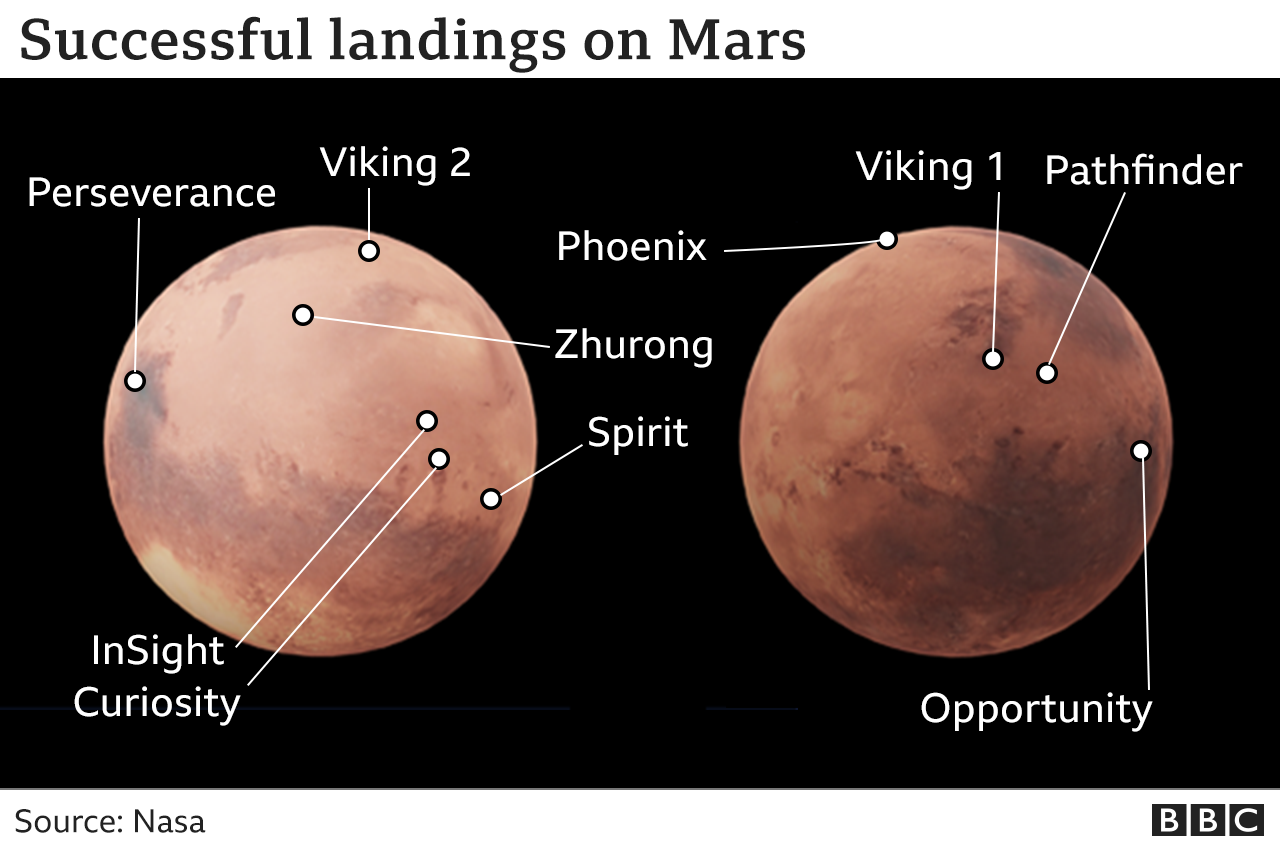
Related Topics
Quelle: BBC
----
Update: 7.09.2021
.
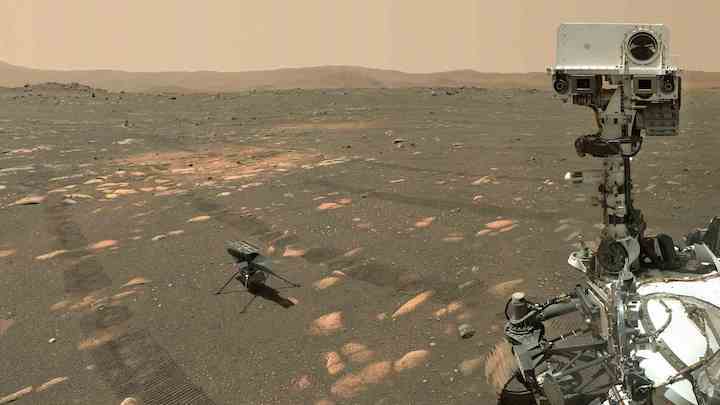
The Perseverance Mars rover in a selfie with the Ingenuity helicopter (L), April 6, 2021. /NASA
NASA's helicopter on Mars, Ingenuity, was only supposed to fly five times, yet it has completed 12 flights and isn't ready to retire.
Given its unexpected success, the U.S. space agency has extended Ingenuity's mission indefinitely.
The tiny helicopter has become the regular travel companion of the rover Perseverance, whose core mission is to seek signs of ancient life on Mars.
"Everything is working so well," said Josh Ravich, the head of Ingenuity's mechanical engineering team. "We're doing better on the surface than we had expected."
On April 19, Ingenuity carried out its maiden flight, making history as the first motorized craft to fly on another planet.
Exceeding all expectations, it has gone on to fly 11 more times.
"We've actually been able to handle winds greater than we had expected," Ravich told AFP.
"I think by flight three we had actually accomplished all of our engineering goals ... (and) got all the information we had hoped to get," said Ravich, who works for NASA's famed Jet Propulsion Laboratory, which developed the helicopter.
Since then, Ingenuity has flown as high as 12 meters, and its last flight lasted two minutes and 49 seconds. In all, it has covered a distance of about 2.6 kilometers.
In May, Ingenuity flew its first one-way mission, landing outside the relatively flat "airfield" that had been carefully selected as its initial home.
But not all has gone smoothly. Its sixth flight brought some excitement.
After being knocked dangerously off-balance by a malfunction affecting the photos taken in flight to help it stabilize, the tiny craft was able to recover. It landed, safe and sound, and the problem was resolved.
Ingenuity is now being sent out to scout the way for Perseverance, using its high-resolution color camera.
The purpose is twofold: to chart a path for the rover that is safe, but also which is of scientific interest, notably in geological terms.
What explains its longevity?
"The environment has been very cooperative so far: the temperatures, the wind, the sun, the dust in the air... It's still very cold, but it could have been a lot worse," said Ravich.
In theory, the helicopter should be able to keep operating for some time. But the approaching Martian winter will be challenging.
NASA engineers, now armed with the data from Ingenuity's flights, are already working on its next-generation successors.
"Something in the 20 to 30 kilograms (range) maybe, able to carry science payloads," said Ravich.
Those future payloads might just include the rock samples collected by Perseverance.
NASA is planning to retrieve those samples during a future mission – sometime in the 2030s.
NASA’s Perseverance Rover Collects First Mars Rock Sample
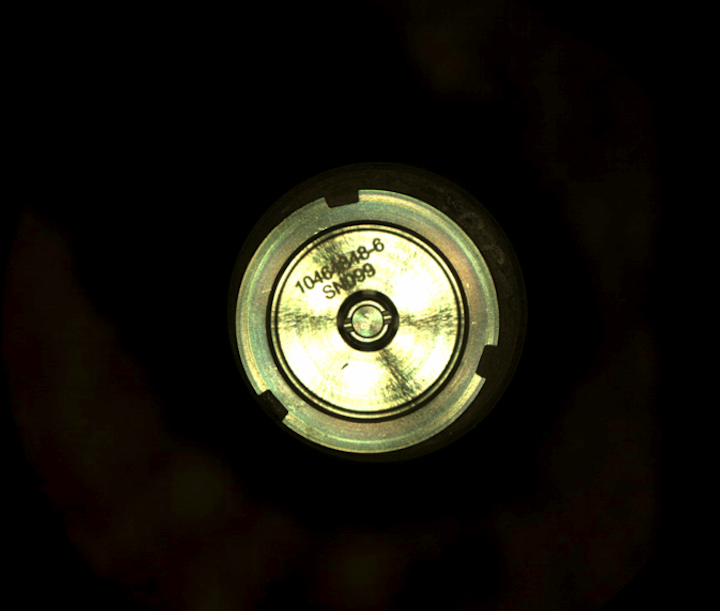
NASA’s Perseverance rover today completed the collection of the first sample of Martian rock, a core from Jezero Crater slightly thicker than a pencil. Mission controllers at NASA’s Jet Propulsion Laboratory (JPL) in Southern California received data that confirmed the historic milestone.
The core is now enclosed in an airtight titanium sample tube, making it available for retrieval in the future. Through the Mars Sample Return campaign, NASA and ESA (European Space Agency) are planning a series of future missions to return the rover’s sample tubes to Earth for closer study. These samples would be the first set of scientifically identified and selected materials returned to our planet from another.
“NASA has a history of setting ambitious goals and then accomplishing them, reflecting our nation’s commitment to discovery and innovation,” said NASA Administrator Bill Nelson. “This is a momentous achievement and I can’t wait to see the incredible discoveries produced by Perseverance and our team.”
Along with identifying and collecting samples of rock and regolith (broken rock and dust) while searching for signs of ancient microscopic life, Perseverance’s mission includes studying the Jezero region to understand the geology and ancient habitability of the area, as well as to characterize the past climate.
“For all of NASA science, this is truly a historic moment,” said Thomas Zurbuchen, associate administrator for science at NASA Headquarters in Washington. “Just as the Apollo Moon missions demonstrated the enduring scientific value of returning samples from other worlds for analysis here on our planet, we will be doing the same with the samples Perseverance collects as part of our Mars Sample Return program. Using the most sophisticated science instruments on Earth, we expect jaw-dropping discoveries across a broad set of science areas, including exploration into the question of whether life once existed on Mars.”
First Sample
The sample-taking process began on Wednesday, Sept. 1, when the rotary-percussive drill at the end of Perseverance’s robotic arm cored into a flat, briefcase-size Mars rock nicknamed “Rochette.”
After completing the coring process, the arm maneuvered the corer, bit, and sample tube so the rover’s Mastcam-Z camera instrument could image the contents of the still-unsealed tube and transmit the results back to Earth. After mission controllers confirmed the cored rock’s presence in the tube, they sent a command to complete processing of the sample.
Today, at 12:34 a.m. EDT, Perseverance transferred sample tube serial number 266 and its Martian cargo into the rover’s interior to measure and image the rock core. It then hermetically sealed the container, took another image, and stored the tube.
“With over 3,000 parts, the Sampling and Caching System is the most complex mechanism ever sent into space,” said Larry D. James, interim director of JPL. “Our Perseverance team is excited and proud to see the system perform so well on Mars and take the first step for returning samples to Earth. We also recognize that a worldwide team of NASA, industry partners, academia, and international space agencies contributed to and share in this historic success.”
First Science Campaign
Perseverance is currently exploring the rocky outcrops and boulders of “Artuby,” a ridgeline of more than a half-mile (900 meters) bordering two geologic units believed to contain Jezero Crater’s deepest and most ancient layers of exposed bedrock.
“Getting the first sample under our belt is a huge milestone,” said Perseverance Project Scientist Ken Farley of Caltech. “When we get these samples back on Earth, they are going to tell us a great deal about some of the earliest chapters in the evolution of Mars. But however geologically intriguing the contents of sample tube 266 will be, they won’t tell the complete story of this place. There is a lot of Jezero Crater left to explore, and we will continue our journey in the months and years ahead.”
The rover’s initial science foray, which spans hundreds of sols (Martian days), will be complete when Perseverance returns to its landing site. At that point, Perseverance will have traveled between 1.6 and 3.1 miles (2.5 and 5 kilometers) and may have filled as many as eight of its 43 sample tubes.
After that, Perseverance will travel north, then west, toward the location of its second science campaign: Jezero Crater’s delta region. The delta is the fan-shaped remains of the spot where an ancient river met a lake within the crater. The region may be especially rich in clay minerals. On Earth, such minerals can preserve fossilized signs of ancient microscopic life and are often associated with biological processes.
More About Perseverance
A key objective for Perseverance’s mission on Mars is astrobiology, including the search for signs of ancient microbial life. The rover will characterize the planet’s geology and past climate, pave the way for human exploration of the Red Planet, and be the first mission to collect and cache Martian rock and regolith.
Subsequent NASA missions, in cooperation with ESA, would send spacecraft to Mars to collect these sealed samples from the surface and return them to Earth for in-depth analysis.
The Mars 2020 Perseverance mission is part of NASA’s Moon to Mars exploration approach, which includes Artemis missions to the Moon that will help prepare for the first human exploration mission to the Red Planet.
JPL, which is managed for NASA by Caltech in Pasadena, California, built and manages operations of the Perseverance rover.





